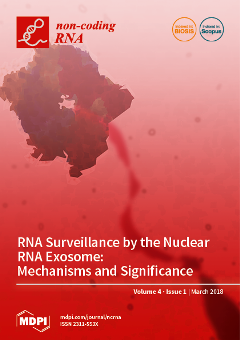A novel antisense transcript was identified in the human telomerase reverse transcriptase (
hTERT) promoter region, suggesting that the
hTERT promoter is bidirectional. This transcript, named
hTERT antisense promoter-associated (
hTAPAS) RNA, is a 1.6 kb long non-coding RNA.
hTAPAS transcription
[...] Read more.
A novel antisense transcript was identified in the human telomerase reverse transcriptase (
hTERT) promoter region, suggesting that the
hTERT promoter is bidirectional. This transcript, named
hTERT antisense promoter-associated (
hTAPAS) RNA, is a 1.6 kb long non-coding RNA.
hTAPAS transcription is initiated 167 nucleotides upstream of the
hTERT transcription start site and is present in both the nucleus and the cytoplasm. Surprisingly, we observed that a large fraction of the
hTERT polyadenylated RNA is localized in the nucleus, suggesting this might be an additional means of regulating the cellular abundance of hTERT protein. Both
hTAPAS and
hTERT are expressed in immortalized B-cells and human embryonic stem cells but are not detected in normal somatic cells.
hTAPAS expression inversely correlates with
hTERT expression in different types of cancer samples. Moreover,
hTAPAS expression is not promoted by an
hTERT promoter mutation (-124 C>T). Antisense-oligonucleotide mediated knockdown of
hTAPAS results in an increase in
hTERT expression. Conversely, ectopic overexpression of
hTAPAS down regulates
hTERT expression, suggesting a negative role in
hTERT gene regulation. These observations provide insights into
hTAPAS as a novel player that negatively regulates
hTERT expression and may be involved in telomere length homeostasis.
Full article






